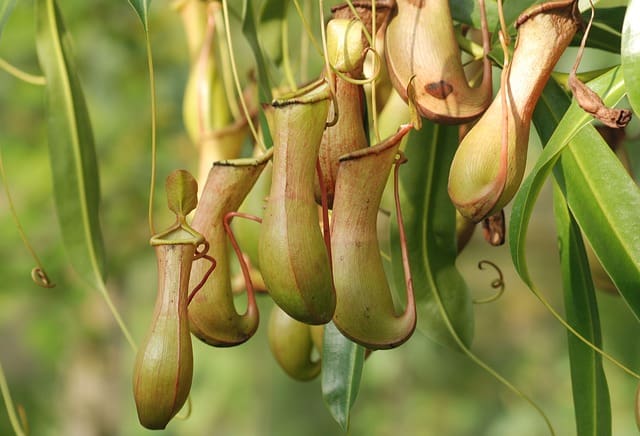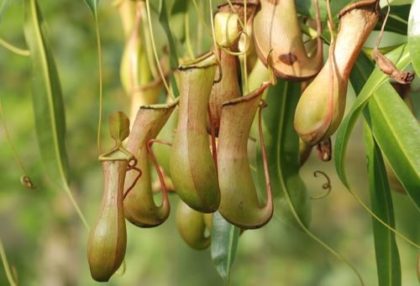Before buying Pitcher plants to grow at home I did in-depth research to investigate Pitcher plants are safe to grow at home. Luckily, I found some encouring information.
Pitcher plants are not poisonous to humans or pets. Also, contact with Pitcher plants is completely harmless. These plants make up safe and beautiful houseplants.
This article will give you an overview on how Pitcher plants can make up great houseplants. Also, it will give you pointers to avoid harming Pitcher plants.
Are Pitcher Plants Poisonous to Humans?
Pitcher plants are unable to poison humans not only if they accidentally come in contact with either their digestive fluid or any other part of the plant; pitcher plants are also non-toxic to such a degree that they are being eaten in some parts of the world.
In Malaysia, for example, people like to snack on _lemang periuk kera_, which is a dish made of sticky rice that is wrapped in the trap of a pitcher plant which is then cooked in coconut milk. As you can see, you are more likely to eat a nepenthes than it is likely for them to eat you!
While your children should not attempt to eat up a whole pitcher plant, they are harmless to the touch and even way safer than other popular house plants. Nepenthes pose no threat to the curious fingers of exploring toddlers.
Are Nepenthes Poisonous to Cats and Dogs?
As all pet owners know, it is close to impossible to hinder either cats or dogs from putting things in their mouths. They like nibbling at and licking everything they can get to, be it actual food, furniture, or houseplants. In the latter case, a carnivorous and exotic plant might give the impression that it poses a risk. Especially cats are known to be attracted to plants because they enjoy their fibrous texture that, when it is consumed in small amounts, or when it comes in the form of special plants like kitty grass, can aid their digestion.
There is no reason to worry about your cat’s health when it happened to eat part of a Pitcher plant. Digesting a few bites of a Nepenthes might result in mild digestive issues in cats but usually does not lead to the display of any serious, long-lasting effects.
In the case that your pet has consumed large quantities of such a plant, though, there are nevertheless some symptoms that you should keep an eye out for: if you notice your cat vomiting a lot, suffering from diarrhea, being unusually lethargic, or displaying a rash or any other kind of irritation around their mouth you should contact a vet. When you need to visit a veterinarian because of symptoms like these, it makes a lot of sense when you take a piece of your pitcher plant with you, so that they know what they are dealing with and can assess the situation quickly and competently.
In general, it will be more important to save the plant from your pet and not the other way round. There are some things you can do to avoid your house plants ending up chewed up or shredded. Some plants even defend themselves by their taste. Venus flytraps, another well-loved carnivorous plant, for example, are known to taste sour and thus not to be to the liking of cats.
To protect plants with a more delicious taste from maltreatment by a cat, you can make sure that your cat always has some kitty grass or catnip to keep them busy. Aside from that, you should try to put your nepenthes in locations that the cat cannot reach. While cats might be likely to crawl up shelves and jump onto whatever when it comes to dogs it is often enough to simply put your plant somewhere up high. A hanging planter is a good idea in both cases. Just make sure to put it somewhere in the room where the cat cannot jump to from other high locations.
Are Pitcher Plants Dangerous in Any Way?
Back in the 19th century, the European adventurers and explorers traveling the world brought back home stories of cruel, man-eating plants that lurk in exotic rain forests. Nowadays we know that this is not true. Now we know that nepenthes do not grow remotely tall enough to ingest a human being. Nevertheless, this shows that pitcher plants have fascinated and scared human beings for a long time. Especially the most well-known of them, which are the species that belong to the genus called nepenthes, drew botanists as well as laypeople in by being both scary and undeniably beautiful.
Both intrigued and somehow a little fearful we still like to observe the insects that fall into the trap of a pitcher plant. But, are these carnivorous plants poisonous unsafe to be kept as house plants?
No species of the Pitcher plant is dangerous to human beings – or any other animal that is bigger than a small rodent, for that matter. Even if you were to put your finger inside and move it around, nothing would happen to you. If you handle the pitcher too roughly, though, you will damage the plant rather than yourself.

Since a pitcher plant takes three to five days to ingest a small insect, a human being would have to spend a long time simply holding their hand into a pitcher of a nepenthe to even feel a thing.
The tallest Nepenthes, which are those that are to be found in the rainforests of Southeast Asia and that can grow up to 5 feet tall, has never been known to ingest anything bigger than frogs or rats.
Do Nepenthes Make Good Houseplants?
Now, that you know pitcher plants are completely safe. It is time to consider growing them in your home.
There are a lot of reasons why Pitcher plants make excellent house plants. It is simply fascinating to observe such an unusual plant that not many people have in their homes. They exhibit fascinating insect trapping mechanisms and act as bug controllers.
When owning a Pitcher plant, you will be able to witness how insects, lured in by the sweet-smelling nectar fall into the pitcher. Then they are prohibited from crawling out again, by various elements contained on the inside wall of the pitcher, for example by thin hairs pointing inward and downward and thus locking the insect in the trap. Consequently, they are stuck at the bottom of the pitcher, surrounded by digestive fluid, where, in a couple of days, they get ingested and turn into a sticky, soup-like substance from which the nepenthes draws the nutrients it needs.
Bug control is one of the aspects that make pitcher plants and other carnivorous plants so attractive to many fans of house plants. They can, for example, digest gnats, spiders, flies, and other small insects.
When you put them at a place where insects have a tendency to enter the room, like on a window sill, or close to a door, it will most likely not be required for you to feed them.
If you have absolutely no insects in your apartment, it might be necessary to provide food for your nepenthes, though. In this case, you can try to find some insects yourself, but if those are difficult to come by, goldfish flakes from a pet store are also a good solution. You might also be enticed to share your lunch or dinner with your pitcher plant, but you need to resist this temptation! Do not feed them chunks of meat, or any human food, they will not be able to digest it.
The location of your plant should be warm and humid. Chose a bright place that receives at least six hours of direct sunlight a day. They thrive best in temperatures between 60 and 85 F.
Pitcher plants grow best in soil that is poor in nutrients. A mixture of moss and perlite works well. Refrain from using potting mixes or fertilizers. It is important to always keep the soil wet during the growing season, which continues from May to October. Do not put water directly into the pitchers, though!
During winter, some pitcher plants like to go dormant, which is something like the hibernation we know from some animal species. This period of dormancy can take from three to five months. During this time the plant does not require light and is happy with a cooler and dryer climate. Any newly developing pitchers should be covered by a layer of mulch.
Once you have decided which species of pitcher plant you want, you need to look up their needs in winter, since not only the lengths of their dormancy vary, some of them do not go dormant and keep on growing instead, which results in them needing even more care than in the warmer months.
There are several species of nepenthes available for cultivation indoors that grow beautiful pitchers in colors ranging from light green to dark maroon that can be, depending on the species, location, and care, grow up to 20 or even 30 cm long. Along the big spectrum of pitcher plants, everyone is sure to find the right species for their home and possibilities.


